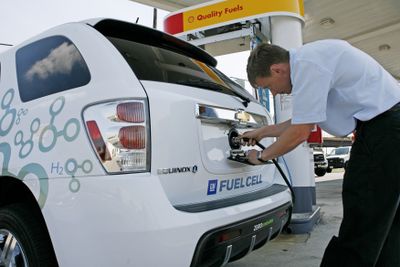Hydrogen cars get test-drives
Prototypes offer zero emissions but face logistical challenges

WASHINGTON – Tom Albert drove his loaner Chevrolet Equinox like any other car.
He took it to work during the week, picked up groceries, and loaded up the back with bags of soil at the garden store. When his infant son was fussy, Albert drove the newborn around the block to calm him down.
The normal driving experience ended, however, when it came time to fuel the car. Aboard the silent vehicle, Albert had two filling stations to choose from in the Washington, D.C., area, and the fuel – hydrogen – was anything but typical.
Albert’s no-cost behind-the-wheel experience last spring was part of an ongoing program by General Motors Corp. to see if next-generation vehicles powered by hydrogen can become a reality. Automakers such as GM, Honda Motor Co. and BMW AG are putting several hundred vehicles into suburban garages, in cities and on the highway to see how they fare in day-to-day driving.
Hydrogen fuel cells have been part of the auto industry’s roster of advanced vehicles for years, and several companies are testing small fleets. They gained attention when President Bush announced in 2003 that the government would invest $1.2 billion to encourage their development.
The Equinox, which holds about 4 kilograms of pressured hydrogen in tanks, generates electricity from a reaction between hydrogen and oxygen and delivers the gasoline equivalent of about 43 miles per gallon. While hydrogen is highly flammable, the hydrogen would diffuse into the air in a nonflammable concentration if one of the tanks was punctured or leaked.
The zero-emissions vehicles, which emit droplets of water, still face high hurdles because of a lack of fueling stations and the high cost of developing the cars. Auto companies do not disclose costs, but the vehicles can cost $1 million and beyond because most are hand-built prototypes.
Hydrogen is typically extracted from natural gas, oil and coal, releasing carbon dioxide from those fuels into the atmosphere. Industry officials say using fossil fuels to make hydrogen is a transitional step, with the ultimate goal to produce it widely through renewable energy sources.
Patrick Serfass, director of technology development for the National Hydrogen Association, said using natural gas to produce hydrogen emits half the amount of overall emissions compared with a conventional gasoline-fueled vehicle.
The test drives are being held while consumers are paying close to $4 for a gallon of gasoline, offering a window into what petroleum-free driving might look like.
The industry estimates hydrogen can be produced for the equivalent of $3-a-gallon gasoline with current technology, while the government’s target is for the fuel to be available at $1.50 per gallon of gasoline equivalent by 2010.